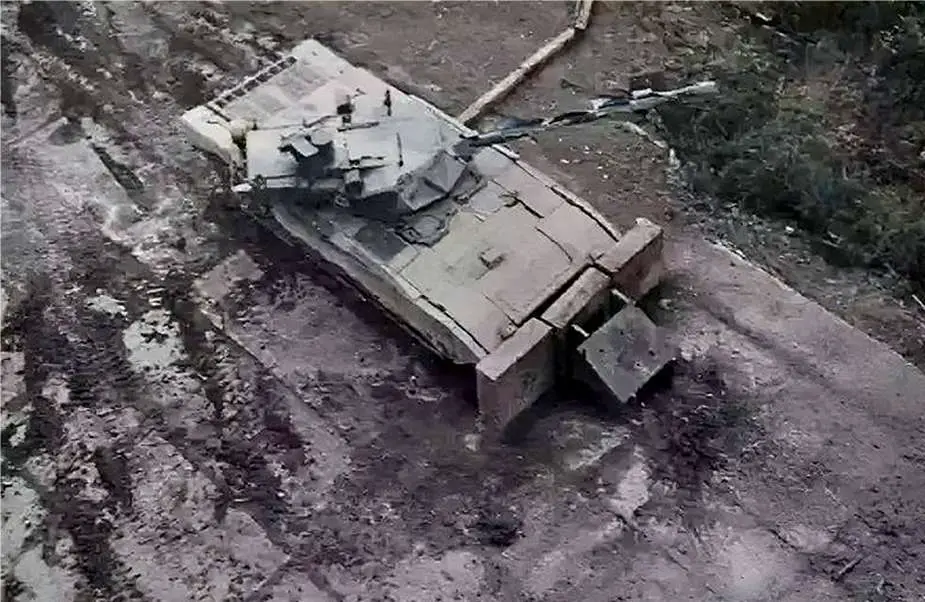Breaking news
Russia successfully tests active protection system Afganit on T-14 Armata tank.
According to an article by Topcor on August 24, 2023, the Russian Ministry of Defense had successfully carried out tests of its Afganit Active Protection System (APS) using the T-14 Armata tank. These tests occurred as the tank entered its final stages before its mass production. The credibility of this information is confirmed by images presented at the Army-2023 event, which displayed the test results at Stand 38 of the Scientific Research Testing Institute of Armored Weapons and Equipment under the Ministry of Defense of the Russian Federation.
Follow Army Recognition on Google News at this link

Russia successfully tested its active protection system Afganit on the T-14 Armata tank (Picture source: Russian MoD)
These images highlighted advancements in Russia's armored defense capabilities, with a specific focus on the Afganit APS trial on the T-14 Armata tank. The trial was conducted under controlled conditions, with the tank safeguarded by thick metal screens to prevent undue hull damage during testing.
The primary aim of the trial was to assess the effectiveness of the Afganit system in detecting and neutralizing a variety of incoming threats, including anti-tank guided missiles (ATGMs), rockets, and other projectiles. The proceedings were overseen by a group of engineers and military experts who evaluated the system's responsiveness, accuracy, and overall performance.
The results of the trial appeared to be positive, as the Afganit system effectively intercepted and nullified the simulated threats. The system's radar and optical direction finders successfully identified incoming projectiles, and the countermeasures were promptly and accurately deployed. However, some minor damage was observed on the tank barrel's thermal insulation, likely due to the close detonation of ammunition. This damage, though minor, suggests the realism of the testing and its alignment with potential real-world scenarios.
The Afganit APS represents a notable advancement in Russian military technology. It is a comprehensive system designed to enhance the defensive capabilities of armored vehicles, particularly against contemporary threats that conventional armor might struggle to mitigate. Outfitted with advanced long-range radars and optical direction finders, the system ensures early detection of threats, enabling swift responses.
The APS incorporates both "soft-kill" and "hard-kill" strategies. "Soft-kill" measures encompass tactics like deploying aerosol screens and electronic jamming to disrupt the guidance systems of incoming missiles. On the other hand, "hard-kill" measures involve physically intercepting and destroying threats using precisely timed countermeasures. The integration of these strategies allows Afganit to adapt to diverse threats, creating a multi-layered defense mechanism.
Nonetheless, the system encounters challenges and limitations. Concerns persist about its ability to counter specific advanced ATGMs, such as the TOW-2B and Javelin, as well as sub-caliber shells armed with depleted uranium. Some experts question the system's efficacy against certain ATGM variants, underscoring the intricate hurdles involved in devising a universally effective defense mechanism.
The dynamic landscape of Active Protection Systems (APSs) within modern warfare underscores the evolving nature of military technology. These systems are now integral components of armored vehicles, aimed at providing protection against an array of threats, including sophisticated anti-tank weapons, guided missiles, and unconventional warfare tactics.
APSs commonly employ both "soft-kill" and "hard-kill" approaches. "Soft-kill" strategies strive to disrupt or deceive the guidance systems of incoming threats through methods like deploying smoke screens, laser dazzlers, or electronic jamming. Meanwhile, "hard-kill" strategies aim to physically intercept and neutralize incoming threats using counter-projectiles or explosive charges. Striking the right balance between these strategies is crucial for adapting to diverse threats and scenarios.
The integration of APSs with existing armor presents a complex design challenge. The goal is for the system to synergize with the vehicle's existing defense mechanisms. This integration necessitates considerations of weight, power consumption, sensor placement, and countermeasure deployment. The aim is to create a defense system that can effectively respond to various threats without compromising the vehicle's other functionalities.
APSs are anticipated to adapt to the multifaceted and unpredictable nature of modern battlefields, encompassing scenarios like urban warfare, open-field engagements, and asymmetric threats posed by non-state actors. Achieving this adaptability might entail sophisticated sensors, algorithms, and versatile countermeasures.
Numerous countries have developed APSs featuring distinct features and capabilities. The Russian Arena system, for instance, employs radar to detect incoming threats and deploys munitions for interception. The Israeli Trophy system combines radar and optical sensors for threat detection and neutralization. The American Quick Kill system utilizes an Active Electronically Scanned Array to detect threats and employs rocket countermeasures for interception.
The ongoing development and refinement of APSs mirror a broader trend aimed at enhancing the survivability and efficiency of armored vehicles. As threats become increasingly intricate, the role of APSs within defense strategies is likely to expand further.


























